Tell me if this sounds familiar: You started a website and committed to writing blog posts left and right. But after a while, nothing really came of it until you abandoned the project altogether. Meanwhile, your competitor continues to grow thanks to their SEO content marketing services, and you feel helpless to fight back except with a few PPC ads.
This all too common scenario often results from poor strategy, especially when it comes to marketing your material. If content marketing were as easy as being a good writer, we’d all be ranking page 1….or not.
However, to truly understand how to be good at content marketing, you have to master the three Ps:
- Patience
- Persistence
- Promotion
Patience is necessary because content marketing is a long-term strategy that doesn’t yield many results without building up the authority of your domain and association with your brand. Persistence is key because you’ll need to write continuously to build an audience and get more traffic to your website.
And finally, you need master Promotion to get eyeballs on your content, as well as links and good engagement.
However, we could write an entire book on how to be good at content marketing. So instead, we settled on these 19 content marketing tips to help master the art.
1. Align Content with Your Business Goals
First, we need to define what “good content marketing” is, as this can be very subjective for each organization. Ideally, content should align with business goals and existing marketing materials to help build leads, nurture leads to conversion, and make you money.
Meet with your marketing team to outline some baseline goals and key performance indicators your content wants to reach.
For example, we use these metrics to establish a baseline of how well our content is performing:
- Return on Investment (ROI): You want the time and money you put into producing content to lead to profitable results.
- Traffic: Traffic is a raw metric of visibility, which can tell you how well known your brand is.
- Conversions: measure the number of leads that convert from a channel where content is heavily employed, whether on social media, third-party sites, or leads from a blog.
- Page 1 Rankings: While keyword volume is important, no one rarely glances past the forest page of a SERP. We measure the number of keywords in page 1 positions using a tool like SEMrush.
This data will also inform your ongoing strategy for any changes you need to make in the short term to improve your campaign.
2. Research Your Audience
In the field of SEO, keyword research is the ultimate strategy to learn more about your audience. While you may already have some preliminary research, you’ll need to conduct advanced keyword research to uncover what search terms and topics are trending in your industry.
Google’s Keyword Planner is an excellent, free tool to research high-volume keywords and filter your search by competition, YoY change, and, my favorite, top-of-page bid.
 The top-of-page bid is helpful because the highest bid keywords tend to have commercial intent and inform you which keywords are most valuable to your competition. As a side note, keyword intent is especially important because you will not be successful in writing content with commercial intent.
The top-of-page bid is helpful because the highest bid keywords tend to have commercial intent and inform you which keywords are most valuable to your competition. As a side note, keyword intent is especially important because you will not be successful in writing content with commercial intent.
Once you gather a list of keywords, you can build a content strategy centered around ranking for keywords most relevant to your website.
As a bonus, you can also use these keyword research tools, though they all require paid subscriptions.
- Moz
- Ubersuggest
- SEMrush
- Ahrefs
3. Analyze the Competition
One easy way to learn how to do content marketing well is to see what’s working for your competitors using competitor analysis. Fortunately, Google’s Keyword Planner lets you see which keywords your competitors are ranking for.
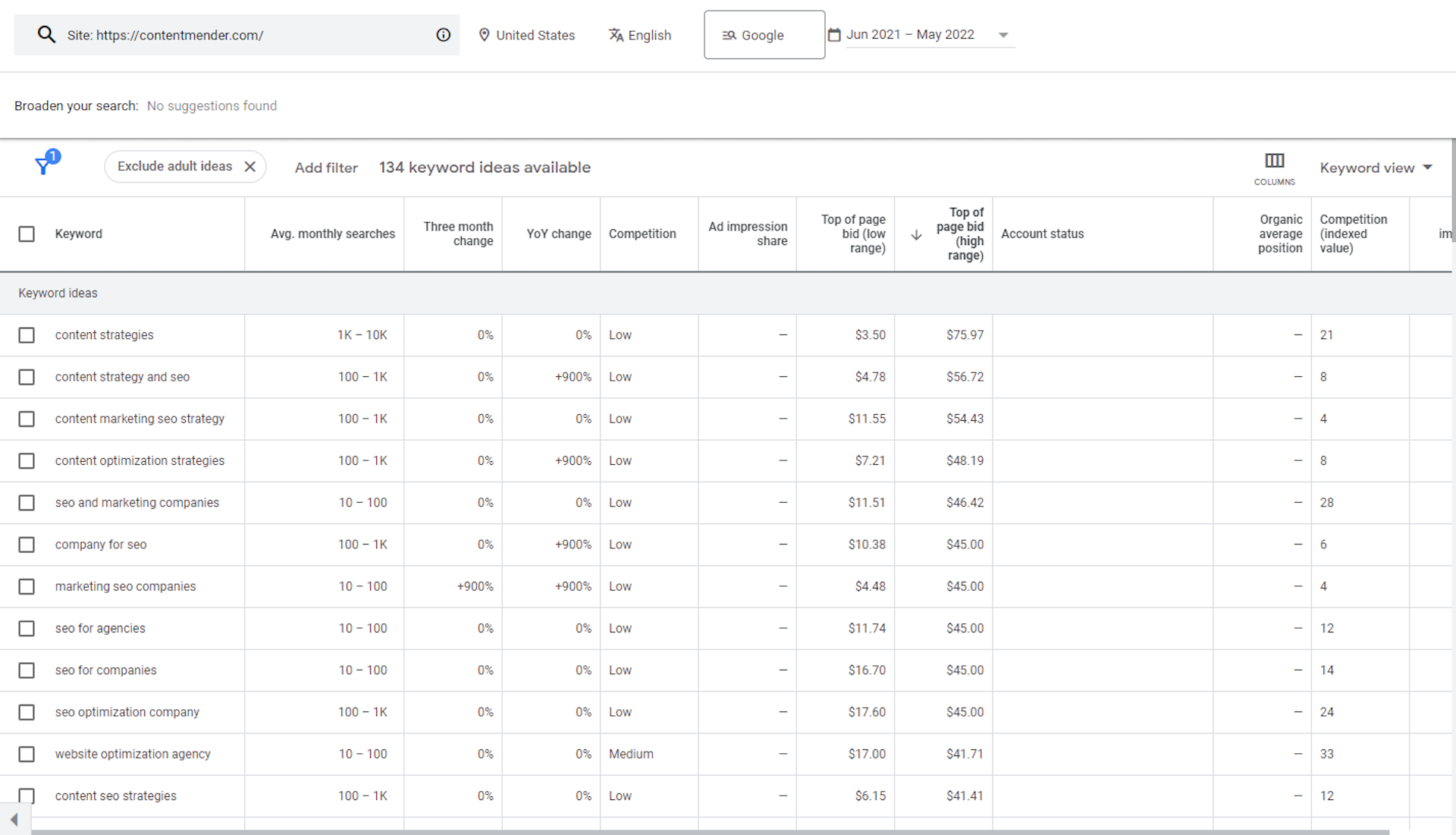
However, this doesn’t tell you what positions competitors are ranking at and what pages are actually driving traffic. For a more detailed report, you’ll need to purchase a competitor analysis tool, such as SEMrush, as seen below.
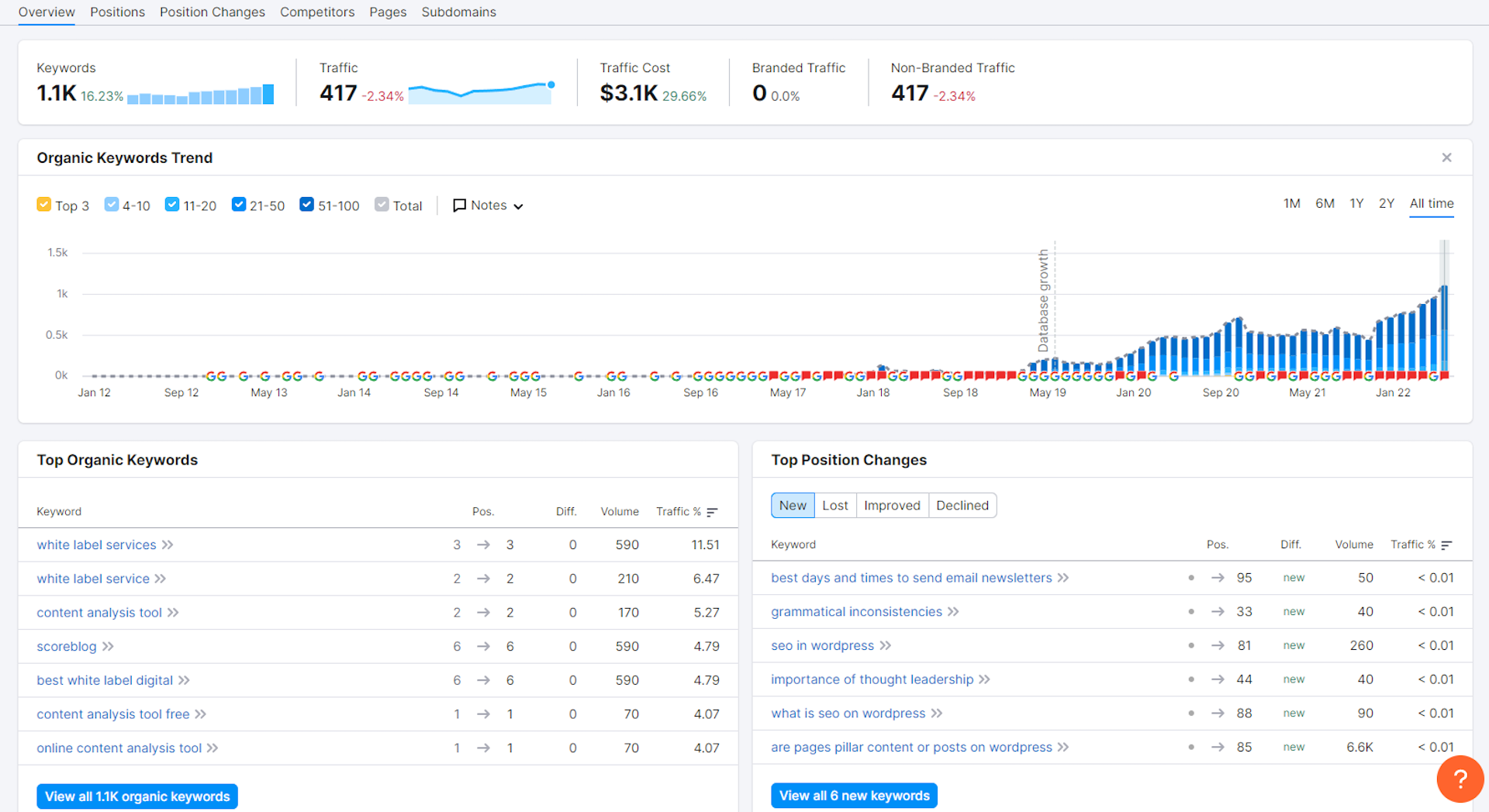
I personally like the Organic Research tool that tells you which pages rank the highest for a given keyword and get the most traffic on a website. SEMrush also provides keyword gap tools to identify opportunities to overcome competitors with new content.
4. Learn How to Find Topics
Before we discuss making a content marketing plan, you need to learn how to choose topics to write about and create content around. Again, SEMrush provides an amazing Topic Research tool that pulls up the top-ranking content around a topic and several related subtopics.
The key is to find topics around informational intent. Most keyword tools allow you to filter by intent, but you can use your judgment. For example, long-tail keywords and question phrases typically signal informational intent.
There are several content analysis tools to find topic ideas, which you can plug into Google’s Keyword Planner or Google Trends to view search volume. However, there are several free ways to gain keyword and topic ideas.
- Google SERPs
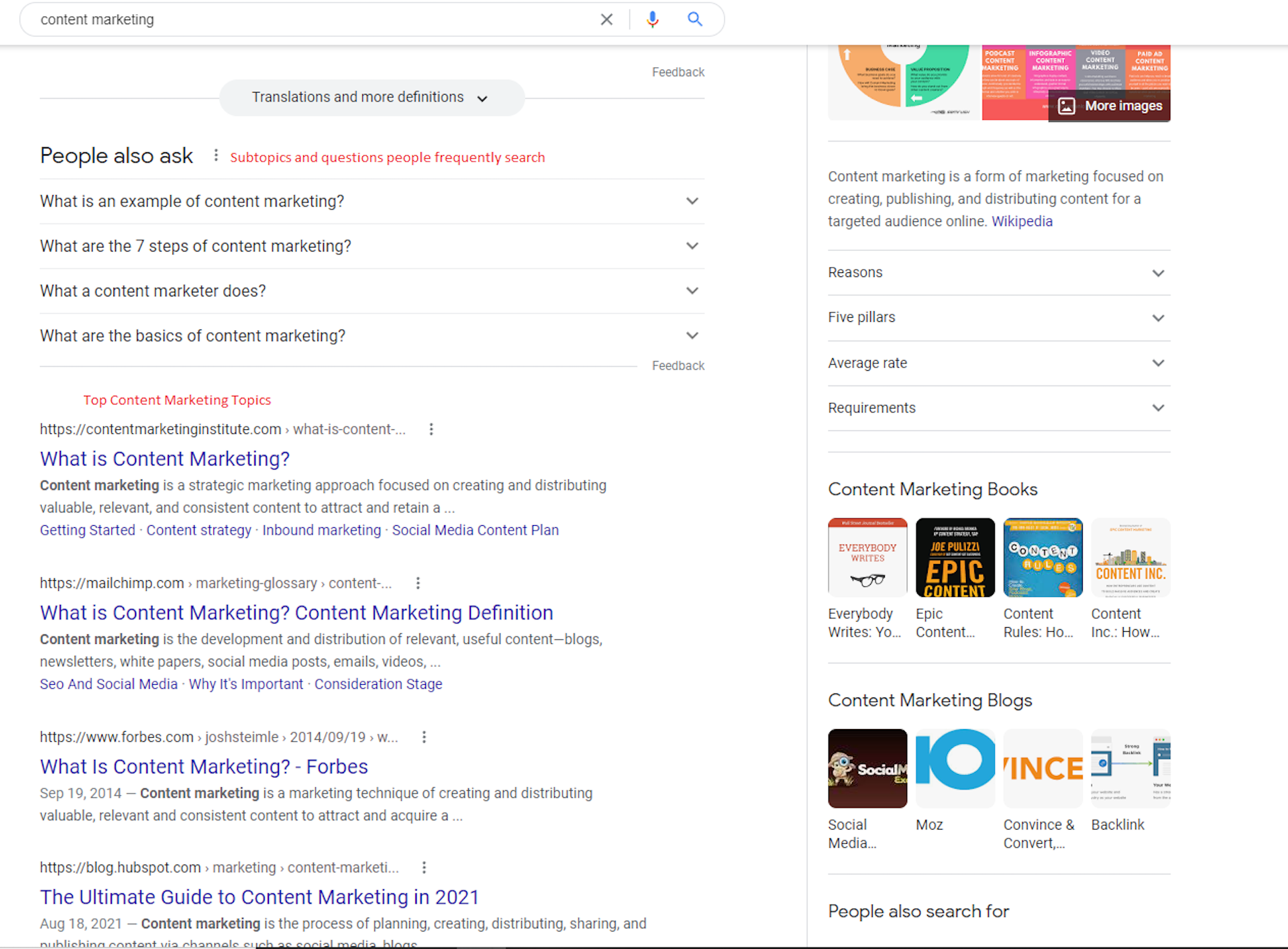
- Google’s Related Searches
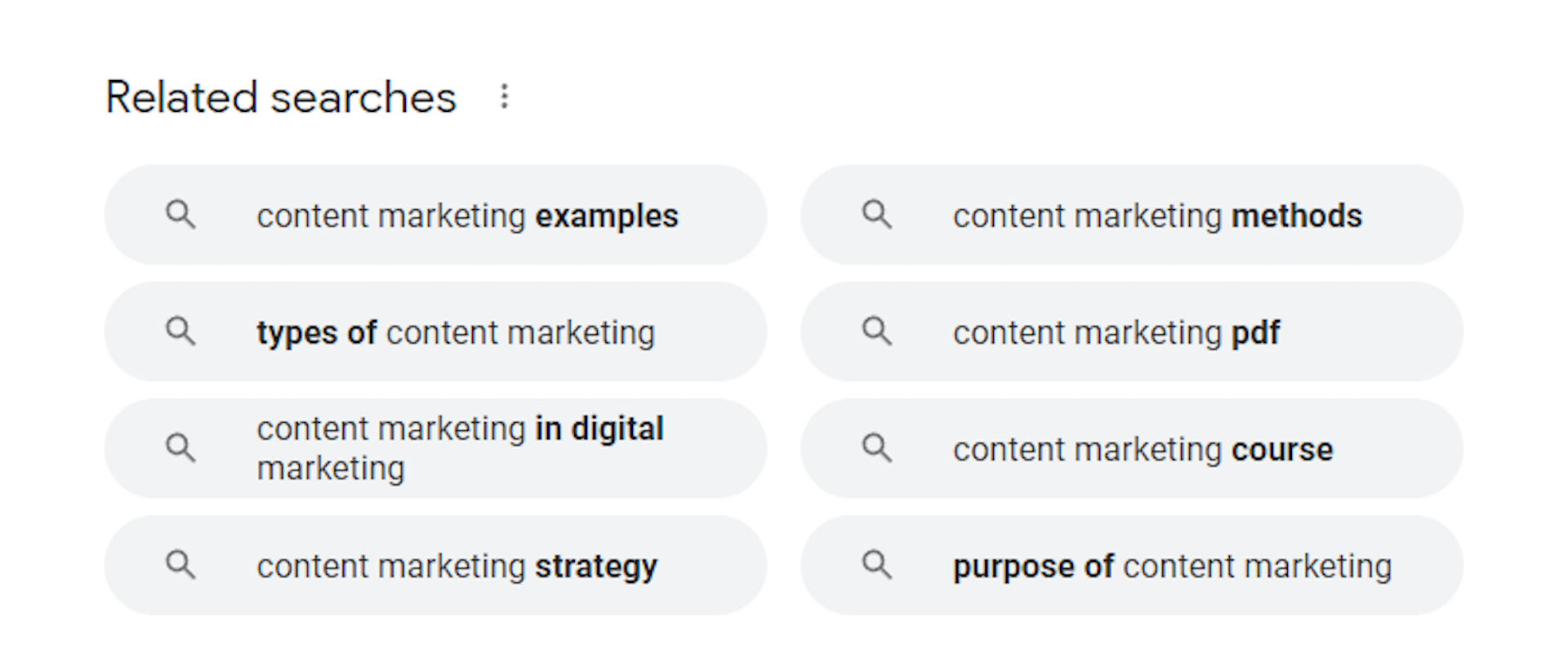
- Google Images
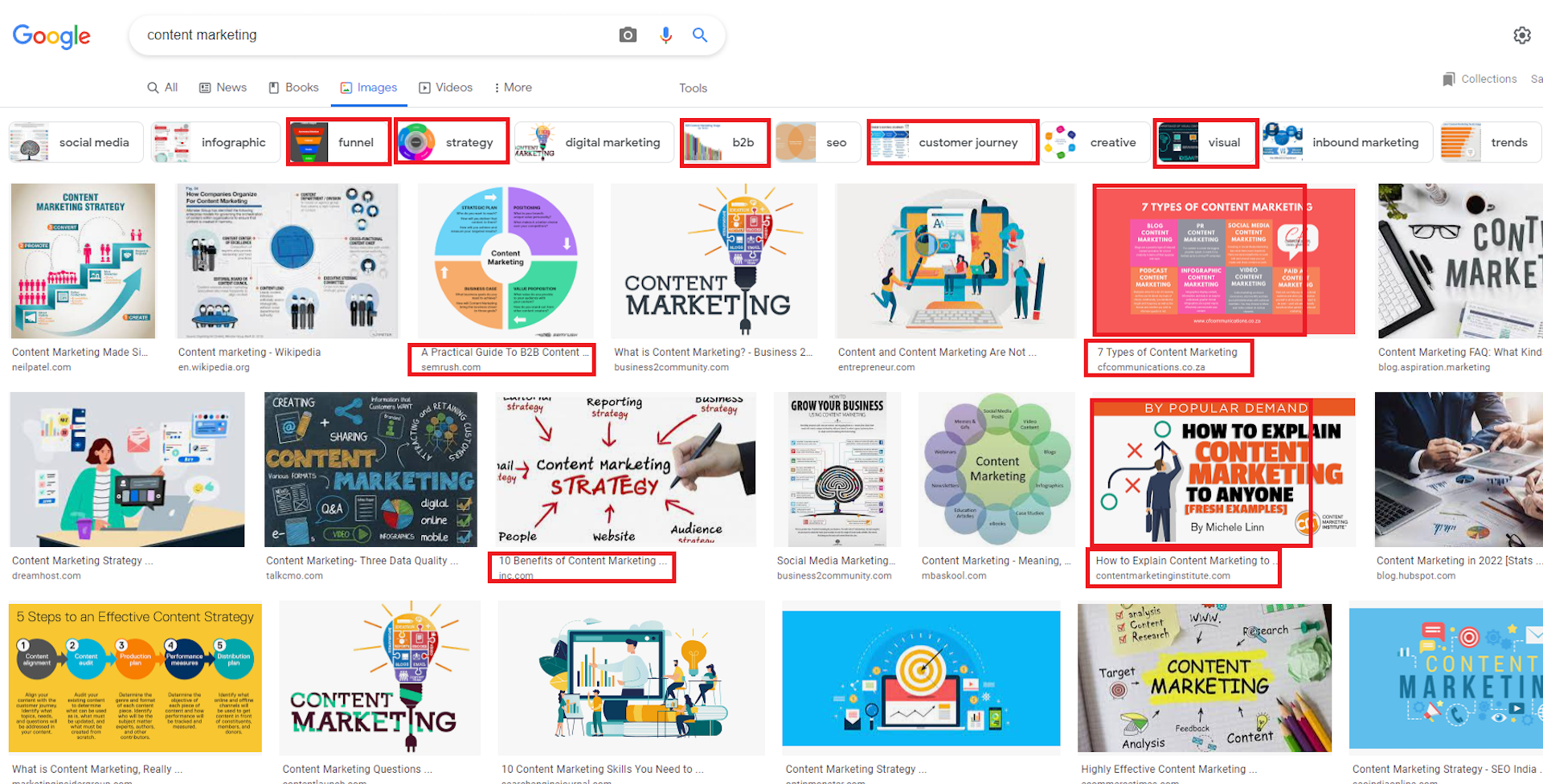
Many topic ideas exist in the top row and underneath each image.
- Forums (e.g., Reddit or niche-specific forum sites)
- Trending topics on Twitter
- Answer the Public
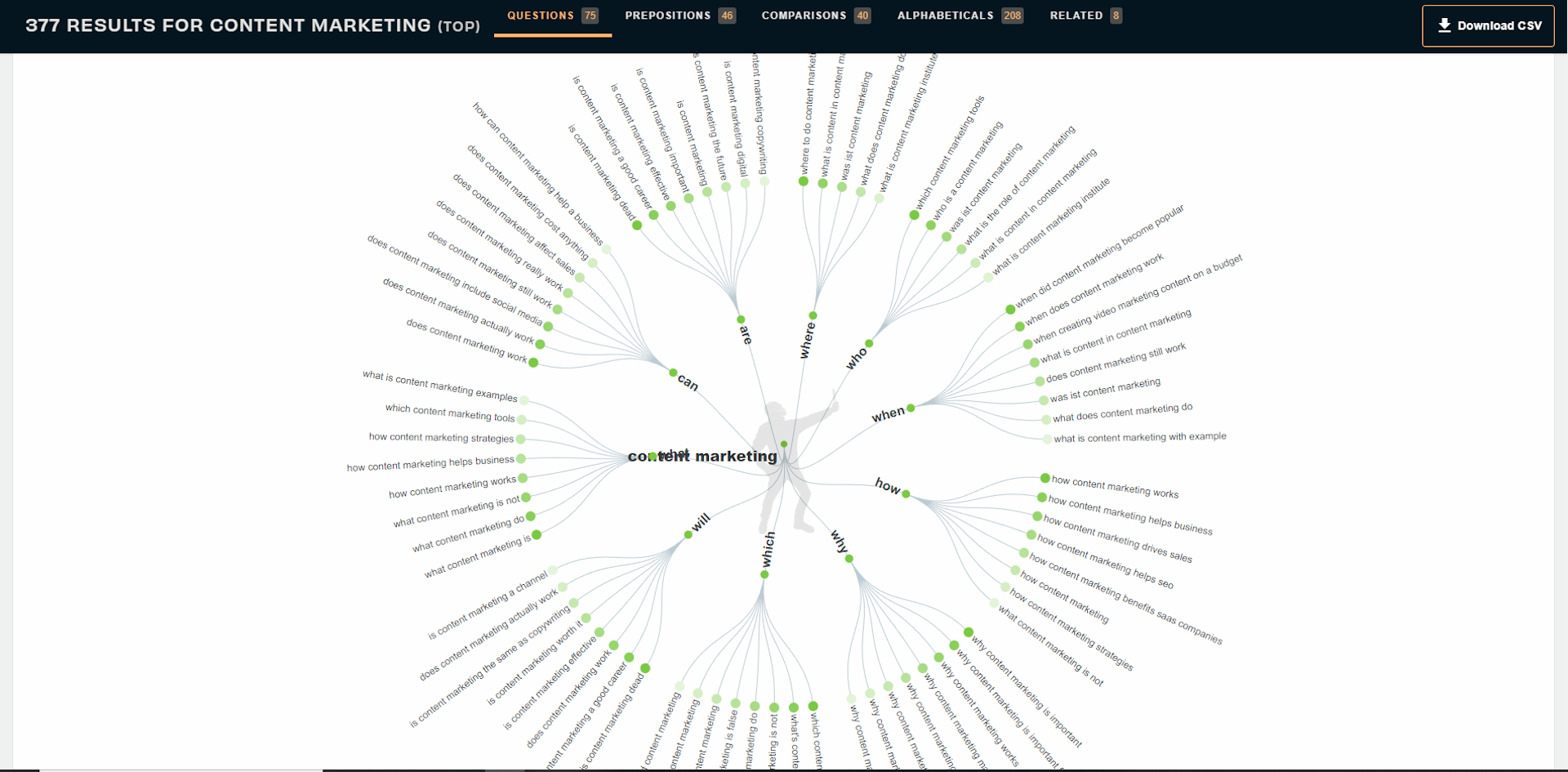
5. Build a Content Marketing Plan
Now that you have a list of keywords and topic ideas, you can devise a plan that aligns with your business objectives. Here are some essentials you’ll need to create a content marketing campaign:
- Calendar: Create a schedule to write, edit, and post content.
- Promotion Channels: Determine which channels make the most sense for a piece of content. For example, PR stories should be boosted on social media and published on newswires.
- Alignment: Align content marketing with PPC and email marketing strategies to streamline the promotion of materials. As a bonus, you can increase your SERP real estate by targeting the same keywords as your paid team.
- KPIs: Be sure to track the specific progress of keywords and different content each month to inform you’re ongoing strategy of what’s working and what’s not.
We use spreadsheets to coordinate our content marketing plan, but project management software works well.
6. Optimize Content for Search Engines
This point may be the most detrimental to your rankings thus far and cause you significant grief.
Unfortunately, content can significantly suffer from poor website UX and technical fundamentals that make search engines reluctant to rank good content.
While there is no magic hack to get content on page 1 with a solid website, there are a few fundamentals you’ll need to clear up to position your content as best as possible to climb the ranks.
- Page Speed: Page speed is not only a direct ranking factor but also impacts user metrics, such as bounce rates and dwell time.
- Website Security: Any website without an SSL certificate will be deemed dangerous by Chrome and drastically cut traffic rates.
- Crawl Budget/Indexation: The last thing you need is an HTTP 4XX error, redirect error, duplicate content, or robots.txt to prevent Google from crawling or indexing your content.
- Navigation: Make sure all pages are internally linked from the homepage or a top-navigation page.
- Keywords: As bright as search engines are, keywords make a world of difference in helping search engines rank content by topic and context. For this reason, employing a target keyword in your title and with a reasonably high density ≥1-2% throughout your text will ensure Google understands the proper context of your piece.
- Structured Data: Structured data is a helpful way to label web pages by broad topical categories, so Google understands what is a blog post, what is not, and what topic that blog post is discussing.
7. Optimize Content for UX
On the flip side, you should write for people, not computers.
Here are a few tips to make your content more UX friendly.
- Segment keywords by intent and choose topics that discuss a pressing user question.
- Answer questions directly and keep content short when possible.
- Employ keywords naturally, always prioritizing the readability of content over its ‘searchability.’
- Employ proper grammar to keep reading smooth.
- Write for a 7th-grade reading level to educate readers. Also, avoid jargon.
- Leverage a strategic internal linking structure to help pass link authority to other relevant pages and provide readers with additional navigation options to keep them engaged on your website.
- Provide external hyperlinks to cite research and help people learn more about a topic.
- Avoid distracting elements, such as slow-loading images or interstitial ads that drive users crazy!
8. Make Content Clickable
However, you need to ask why anyone wants to read or click on your content. Think of your content like an elevator pitch; only the pitch begins with the Google listing.
If you want to improve your click-through rate and keep users engaged with your content, follow these tips below.
- Optimize headlines with keywords relevant to a user’s search (e.g., search phrase “how big do lemon trees grow”; Title: “How Tall Do Lemon Trees Grow? | How to Care for a Lemon Tree”)
- Provide actionable information or list benefits in your headlines (e.g., 10x Your Content or How to Grow Your Web Traffic)
- Chunk content with listicles–research shows people love listicles!
- Optimize your meta description with a target keyword, an overview of the content, and actionable benefits from clicking on your content.
- Leverage a strong hook to keep people engaged when they click on your content. Examples include listing a startling fact, starting a story “in medias res,” or using a strong quote.
9. Make Content Consumable
In addition to making your content clickable, you need to make it consumable. So often, the number one source of bounce rates is people looking for quick explanations to problems who are inundated by paragraphs upon paragraphs of text.
Here are a few tips to keep content consumable and scannable.
- Break up content with bullet points or numbered lists.
- Employ proper spacing between paragraphs or headers to make the content look less condensed.
- Always write content with a long scroll for mobile phones and never on multiple pages.
- Employ images to break up content and reinforce points that don’t need so many words.
- Keep paragraphs between a maximum of 2-3 sentences.
- Answer questions when asked concisely and directly. Avoid fluff!
Another important consideration is investing in a theme on your CMS that’s aesthetically pleasing. Hosting a clean-looking site contributes significantly to your UX.
10. Invest in Long-Form or Evergreen Content
This point may seem like it contradicts the last point, but it’s incredibly easy to keep content consumable, even when writing about long and complex topics.
However, this drives into the nitty-gritty of content, which is establishing yourself as a thought leader. Thought leadership content or evergreen content is written with the express purpose of providing authoritative information around a topic. Ideally, broad pieces of content should answer as many user questions as possible and be as helpful as possible.
While this Backlinko study couldn’t confirm that Google tends to favor long-form content with rankings, long-form content does tend to attract more links, which helps with rankings.
11. Create Actionable Content
In addition to informational content, you also want to mix up your strategy with actionable content. Some examples of actionable content could include:
- Tutorials
- Surveys
- Quizzes
- Calculators
However, your content doesn’t need to be interactive to be actionable; it just needs to address user pain points and provide a reliable solution. For this reason, to make your content more actionable, try to employ these elements:
- Use multiple CTAs to drive action
- Create infographics that tell a story
- Cite research or case studies to prove a point
- List examples to show solutions in action
- Employ video testimonials to provide social proof of products
12. Write Content for Each Stage of the Sales Funnel
This content marketing tip transitions smoothly into our next consideration: writing content for each stage of your sales funnel. This harkens back to the idea of creating content that aligns with business goals and your overal marketing strategy.
Your sales funnel is a multi-stage marketing strategy designed to gain leads and nurture them through a series of steps that eventually lead to a sale or conversion.
While there are multiple iterations of the sales funnel, a generic funnel encompasses three stages:
- Awareness
- Evaluation
- Decision
Based on these stages, you could write content for the following stages:
- Awareness: Blogs, white papers, ebooks, research, podcasts, infographics, social media outreach, guest posts.
- Evaluation: Emails, webinars, FAQs, quizzes, surveys, case studies, testimonials.
- Evaluation: Demos, events, spec sheets, CTAs.
13. Group Content in Clusters
Building topic clusters is just another way of establishing a topic hierarchy on your website. Ultimately, you can strengthen your content by writing about individual subtopics related to a core concept. For example, you could start with the main topic, such as “What Is Content Marketing,” and then link bi-directionally with a subtopic that explores the “costs of content marketing” or “visual content marketing.”
Most importantly, each page helps to rank the other by passing on valuable link equity and can serve as valuable educational material to present as a series or course on your website. For more information, check out our guide to Topic Clusters.
14. Write, Publish, Repeat
Now that you have the skills at your disposal to write amazing content, it’s time to start churning.
Most importantly, you want to create plenty of content to keep readers engaged, whether you’re a blogger or a business looking to serve its customers with educational content.
While frequency is not a ranking signal, linking between content that ranks high gives your website more authority and provides a net positive for all of your content as a whole. Most importantly, writing lots of content keeps readers engaged and helps build an audience.
15. Repurpose Old Content
However, before you click exit, we have a few more tips to help you streamline your content strategy.
We’re often guilty of this mistake, which is failing to leverage old content that used to give us a lot of traffic. It’s easy to post content, enjoy the traffic it gives, and slowly let it fade as you focus forward.
But if you got content sliding back to the 2nd or 3rd pages of a SERP, there is a real opportunity to repurpose that content with fresh information to push it back to the 1st page.
There are several ways to repurpose content and give your website some value again, including:
- Repurposing your content as a YouTube video.
- Repurposing content as an infographic.
- Resharing old, favorited content on social media again.
- Gathering old content and making it all into an ebook.
16. Build Links to Content
If you’ve practiced patience with this article thus far, you’ve finally made it to the last P, which is promotion.
Like it or not, link building still matters in 2022 and is an important signal for ranking content. However, our approach to link building is using it as a promotional opportunity to put eyeballs on our content and grow our audience reach.
Some of our more creative link-building strategies include:
- Reverse engineering competitor links (excellent guide here)
- Guest posting–while not counted, it’s still a great way to build your brand and audience.
- Resource link building
- Building linkable assets (evergreen guides, ebooks, etc.)
- Fixing broken links
- Claiming unlinked brand mentions
17. Share Content to the Right Channels
In addition, you also need to promote content through the right marketing channels to maximize its reach and engagement. These channels include social media and advertisements for reach and email/newsletters to nurture existing customers.
While social media and email are fairly straightforward, advertising your content on a landing page is a great way to build awareness for your brand in a highly competitive industry. Promoting evergreen content also tends to do very well on social media, such as Facebook and Instagram.
18. Outsource Talent to Fill Needs
Of course, if you’re struggling to find quality writers for content, videographers, and graphic designers, it makes sense to hire freelancers or employ content ghostwriting to churn out high-quality and SEO-optimized content.
Ghostwriters can write evergreen content, including long-form blogs, guest posts, and ebooks while keeping everything under your name. As a result, a ghostwriter can help you improve your thought leadership and position your brand as an authority in your industry.
19. Hire a Content Marketing Agency
Finally, if you’re struggling with writing and marketing your content, you can greatly benefit from hiring an SEO agency or white label services. These services give you access to teams of top marketers to help you craft, edit and publish content while giving it maximum traction on promoted channels.
If you’re looking for more help to improve your content marketing strategy or overall SEO campaign, feel free to reach out to our experts here at ContentMender for help.



